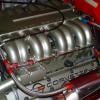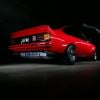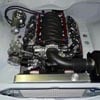Best Suspenion Setup for my Hatch
#26

Posted 04 March 2015 - 07:12 PM
The anti-dive idea is tempting but it could screw with the bump steer again, need to figure out whether its a significant change
#27

Posted 04 March 2015 - 09:46 PM
Sent from my iPhone using Tapatalk
#28

Posted 05 March 2015 - 06:01 AM
#29

Posted 05 March 2015 - 06:26 AM
Size of holes etc
#30

Posted 05 March 2015 - 09:30 AM
What I do is knock the studs out of the existing holes, and use a drill bit in those holes to measure the size (a snug fit in the hole is ideal for the splines to get a grip). Then place the pivot bar in the lowest position possible while still remaining on the flat part of the cross member, centred, and use it to mark the position of the holes.
#31

Posted 05 March 2015 - 02:46 PM
Say I was going for a castor gain / anti-dive setup with an extended upper BJ, how do I work out how much to angle to UCA pivot?
I was thinking about maybe using a couple of G-clamps to secure the UCA while castor measurements were taken, then marking the optimum location for the holes in the K-member, but that seems like the caveman approach.
Does anyone know if there are technical drawings somewhere for a Torana front suspension with measurements I could feed into one of these suspension CAD programs?
#32

Posted 05 March 2015 - 07:33 PM
#33

Posted 05 March 2015 - 07:44 PM
It will depend on how much static castor you are going to run as to how far you want to angle the top arm pivot back. I seem to remember measuring the castor gain was zero through the suspension travel at about 2.5 degrees positive castor on the UC front ends.
Since I am planning to run around 5.5 degrees castor in my setup, my x member was drilled with the pivot angled back 3 degrees so I at least do not lose castor as the suspension travels. I actually wanted mine to stay fairly static through the travel so the suspension was predictable.
This is an approximation, but with the short top arms, it is pretty close and will do for our old Toranas.
The Torana lower arms have some anti-dive built in as well but I have removed this from mine.
#34

Posted 06 March 2015 - 01:44 AM
I've been trying to figure out the angle required when setting up the UCA pivots for anti-dive / castor gain and I think Matt's 3° is pretty darn close...
If you draw a line through the front & rear LCA pivots and a second line through the front & rear UCA pivots, those two lines should eventually intersect somewhere way behind the car, the distance from that point back up to the centre of the upper ball joint must be the radius of the arc in which it now travels.
I have no idea what the distance would actually be but an educated guess for a 3° UCA angle would be a radius of about 230 inches (just under 6 metres) based on an isosceles triangle with one 12 inch side (my guess for the distance between the upper and lower arm pivots)?
So for the purpose of our sums the maximum vertical travel possible is the radius of 230" divided by the 90° it would travel through, so as near as I can figure, every inch of suspension travel (aka "dive") would gain you 2½° of castor on average...
The problem is it doesn't average out, I think it's more of a sliding scale because the first inch of travel doesn't move laterally anywhere near as much as the last inch, there is probably some formula to work that out but I don't know what it is?
All this math makes my head hurt.
#35

Posted 06 March 2015 - 02:32 AM
Sorry, I ran out of edit time on the above post...
Dammit, I think I got that backwards, it should be every 2½" of travel gains you 1° of castor on average, so only 0.39° of castor gain per inch of dive, but on a sliding scale?
If I'm correct, that means we'd need an UCA angle of around 19.2° to get back to the 2½° per inch average, which brings our upper BJ arc back to a radius of just 36"
Is that right? Seems like a big angle?
#36

Posted 06 March 2015 - 06:59 AM
This is a slight oversimplification, but it gives a rough idea and allows us to use basic trig to calculate some numbers.
The upper ball joint travels in an arc, but if we pretend that there are no caster-affecting shims and look at it directly side-on, we only get linear movement for caster gain. Given that a lowered Torana has quite short suspension travel this isn't a big deal to simplify. This linear path is of course set by the angle you mount the arm at, in the example above 3 degrees.
We also (should) know the vertical suspension bump travel that we want to work out the caster change for. In this example I will use 40mm because I know that's about the limit of usable suspension bump from ride height for me. So we want to find out how much further rearward the upper ball joint travels over 40mm of bump with a 3 degree angle.
x
------
\ |
\ |
\ | 40mm
\ |
\ |
3deg
TAN(3) = x / 40
x = 40TAN(3)
x = 2.09mm
So now we know that the ball joint moves back roughly 2mm over this travel, we have to translate back into how many degrees this alters the stub axle. Again we assume for simplicity's sake that the stub axle starts at zero degrees caster. According to my previous rough measurements there is approx 274mm between ball joint pivots, plus the 0.9" (22.86mm) extended ball joint, I'll round to 297mm.
2.09
------
\ |
\ |
\ | 297mm
\ |
\ |
?deg
TAN(?) = 2.09 / 297
? = TAN(-1) * 2.09 / 297
? = 0.403 degrees
So with an upper arm angle of 3 degrees, every 40mm of vertical suspension bump gains an additional 0.4 degrees of caster. Whether this is good, bad, or otherwise depends on how much we require to counteract the dive angle. If we have a maximum of around 0.4 degrees forward tilt (dive) then its pretty good.
Obviously right angle triangles don't model this to a high degree of accuracy but near enough for a starting point. If you really wanted to model this properly using arc formulae etc you can do it with a spreadsheet, but you will need very accurate numbers for components such as the length of upper control arms pivot to pivot etc. Small inaccuracies start to add up quickly when you're calculating everything rather than working from measurements.
#37

Posted 06 March 2015 - 08:09 AM
The lesser the caster change with suspension travel the better. Hitting a bump and increasing/decreasing the caster angle when the suspension height is changed can upset the stability of the vehicle, especially at high speeds, when traveling through corners it can cause a steering feedback feeling like bump steer. Lets say your going through a corner and you hit a bump and the left side changes by a half a degree from 3deg to 2 1/2 degs and the right from 3deg to 3 1/2 degs the vehicle would want to momentarily steer to the left due to one degree variation in caster spread.
Bigfeller I believe the control arm intersection lines would normally intersect at the drive/wheel base.
#38

Posted 06 March 2015 - 11:07 AM
Very good point, anti-dive isn't the only piece of the puzzle and making it uneven would be a problem.
You need a very good idea of when and how far the suspension cycles before getting too deep into this.
Going back to the pro-touring suspension setup info, there is a clear distinction between a modern setup with a lot of travel and big bars, and a more traditional style with heavier springs and shorter travel. It would be a major exercise with coilovers etc to get a Torana into the former category, in the latter its probably just about better without caster gain.
#39
 _Terry_
_Terry_
Posted 17 July 2015 - 10:00 AM
Getting back to the original topic, I have started getting all the Bits ready for the UC K-Frame conversion on my Hatch - plan is to have all new Bushes [Mackay] and Ball Joints [Mogg] then 2 Pack Black the Lot. The problem at the moment is that I have measured the distance between centres of K-Frame/Subframe Mounting Bolts and it is 787.5mm, where the Forum consesus on this this width is 794mm ! Being out of a "High Torque / Low Weight" 4 Cylinder UC, I would have thought that I wouldn't have any sagging issues! Is 6.5mm anything to worry about? Is it within tolerance?
#40

Posted 17 July 2015 - 11:25 AM
I think that k-frame sagging is more to do with kerb-hopping / potholes / etc. than engine torque, usually seen more with stiff springs and shocks but maybe yours has traveled some rough roads in its time?
So long as it still bolts up to the car I wouldn't be too worried, doing a wheel alignment should pretty much tune-out any misalignment.
#41

Posted 17 July 2015 - 12:16 PM
Getting back to the original topic, I have started getting all the Bits ready for the UC K-Frame conversion on my Hatch - plan is to have all new Bushes [Mackay] and Ball Joints [Mogg] then 2 Pack Black the Lot. The problem at the moment is that I have measured the distance between centres of K-Frame/Subframe Mounting Bolts and it is 787.5mm, where the Forum consesus on this this width is 794mm ! Being out of a "High Torque / Low Weight" 4 Cylinder UC, I would have thought that I wouldn't have any sagging issues! Is 6.5mm anything to worry about? Is it within tolerance?
Measure the distance between the centers of the holes in the chassis rails and compare that with the distance between the centers of the K-Frame mount bolts.
If the difference is significant then the K-Frame will be difficult to fit as the K-Frame and/or bushes will have to stretch or compress during installation to line up with the holes in the chassis rails. It is reasonably easy to push the K-Frame bolt centers apart with a jack,
If both measurements are the same then the K-Frame will bolt in easily.
It appears that the K-Frame can twist under heavy braking which will move the front bolts apart and the rear bolts together.
Edited by ls2lxhatch, 17 July 2015 - 12:20 PM.
1 user(s) are reading this topic
0 members, 1 guests, 0 anonymous users




 View Garage
View Garage














